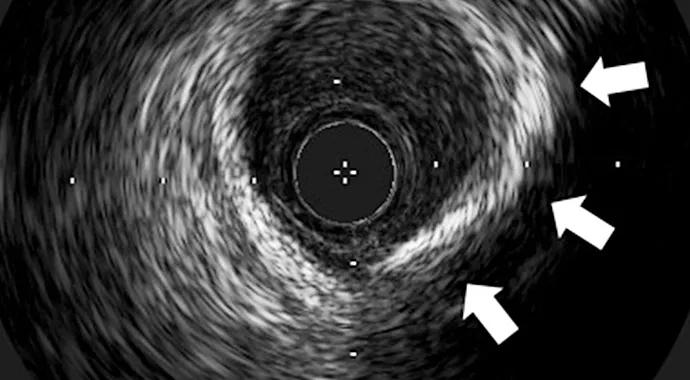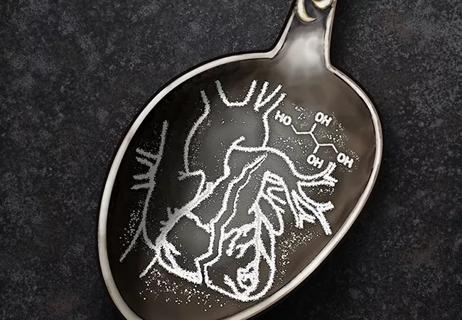Not all coronary calcium is the same, analysis shows

The relationship between coronary artery calcification and atheroma volume is not what it seems. So indicates a recent Cleveland Clinic analysis of serial coronary intravascular ultrasound (IVUS) images of patients participating in eight large clinical trials.
Advertisement
Cleveland Clinic is a non-profit academic medical center. Advertising on our site helps support our mission. We do not endorse non-Cleveland Clinic products or services. Policy
Findings of the analysis, published in the Journal of the American College of Cardiology, include the following:
“Patients prescribed the highest doses of statins, despite achieving low levels of cholesterol and demonstrating marked plaque regression, had changes in plaque calcification that were nearly double the changes in patients who received no statins, and greater than changes in those who received low-intensity statin therapy, both of which were associated with plaque progression,” says the study’s principal investigator, Rishi Puri, MBBS, PhD.
Dr. Puri is a consultant with the Atherosclerosis Imaging Core Laboratory within the Cleveland Clinic Coordinating Center for Clinical Research (C5Research). The studies included in the pooled analysis were run through C5Research.
The increase in calcification revealed by the analysis may represent a means by which statin therapy stabilizes coronary plaque to reduce the risk of cardiovascular events, says the study’s senior investigator, Steven Nissen, MD, who adds that this hypothesis remains to be proved.
“We found that as plaques were getting smaller with statins, they were calcifying,” explains Dr. Nissen, Chairman of the Robert and Suzanne Tomsich Department of Cardiovascular Medicine at Cleveland Clinic.
Advertisement
“It’s exactly the opposite of what you might think intuitively,” he continues. “This is an important observation that tells us that statins work to stabilize plaques by converting softer, cholesterol-laden plaques that are prone to rupture into more stable calcified plaques that are relatively inert. It explains the paradox of why serial measurement of calcium doesn’t necessarily work to track the progression of disease, and it explains to some extent how statins work.”
“These findings show that not all calcium within the coronary arteries is necessarily the same,” Dr. Puri notes. “Rather, it likely depends on the context of a patient’s therapy and its duration, as well as the specific clinical situation. Our findings strongly suggest a calcium-related healing effect following high-dose therapy with potent statins, which could be considered atheroprotective. Our imaging laboratory, along with others, has demonstrated in the past the possible adverse effects of ‘spotty calcification’ found within the coronary tree, the plaques of which seem more resistant to therapies and more frequently found within culprit lesions of patients presenting with acute coronary syndromes.”
CT measurement of coronary calcium has traditionally been used to predict future CAD events. A total calcium score is derived from the extent of calcification detected in the coronary arteries, with higher scores representing more extensive CAD and thus a greater risk of CAD events. Calcium scoring via CT, however, has a much lower resolution compared with IVUS, which can elucidate subtle but significant changes in atheroma calcification (Figure) as well as plaque volume.
Advertisement

Figure. Intravascular ultrasound (IVUS) images representing cross-sections within the left anterior descending artery of (A) a noncalcified atheroma and (B) a calcified atheroma characterized by ultrasonographic shadowing in the region of the arrows.
As part of the pooled analysis, serial IVUS measures of coronary calcification were obtained over 18 to 24 months in 3,495 patients with CAD who received either no statins (n = 224), low-intensity statin therapy (n = 1,726) or high-intensity statin therapy (n = 1,545).
An IVUS calcium index was calculated from each of the IVUS images. The multiple IVUS assessments enabled measurement of both plaque volume change and calcified tissue change across the different patient groups — the first time both measures had been tracked over time and in a substantial number of patients, Dr. Puri says.
All groups had statistically significant increases in plaque calcium indices from baseline; the increases ranged from 0.020 in the no-statin group to 0.038 in the low-intensity statin group to 0.044 in the high-intensity statin group. Models adjusted for atheroma volume showed that changes in calcium indices were significantly greater in both the high-intensity and low-intensity statin groups compared with the no-statin group, but the difference between the high- and low-intensity groups did not quite reach statistical significance.
“What struck me were the differences in changes in plaque calcification between the no-statin and low-intensity statin groups,” says Dr. Puri. “Both groups achieved relatively similar LDL-C levels and demonstrated the same degree of plaque progression over time, yet the increase in calcium index in the low-intensity statin group was nearly double that in the no-statin group. This observation in itself is somewhat telling regarding the possible pro-calcific properties of statins.”
Advertisement
Coronary artery calcification progressed independent of changes in plaque regression or progression, and changes in calcium indices were significantly greater in those with plaque progression than in those with nonprogression or regression.
An accompanying editorial in the Journal of the American College of Cardiology notes the potential importance of the analysis for portraying coronary artery calcification “in a new light,” particularly regarding whether attenuation of coronary artery calcification progression remains a useful goal of statin therapy.
Dr. Nissen says a coronary calcium measurement may be performed once to define a patient’s risk of cardiovascular events, but not when a patient initiates therapy “because the change in calcium isn’t necessarily an accurate predictor of whether or not the patient is benefiting from the therapy.”
Dr. Puri concurs. “More recent findings on CT have confirmed our findings with IVUS,” he says. “Moreover, other groups have demonstrated that the actual density of calcium measured with CT is perhaps more important than simply the total amount of calcium.”
The authors of the editorial call for further investigations to get at the question of whether coronary artery calcification is indeed protective and a sign that further progression of high-risk, low-density plaque is being impeded.
Dr. Puri sees identification of the underlying biological mechanisms of his group’s observations as a focus for future research. “We must explore whether our current and future imaging modalities could be better utilized to more accurately assess calcium morphology within the arterial wall as a means of honing risk prediction for future cardiovascular events,” he says.
Advertisement
Advertisement

Study authors urge reevaluation of the sweetener’s safety designation by food regulators

Surprise findings argue for caution about testosterone use in men at risk for fracture

Findings support emphasis on markers of frailty related to, but not dependent on, age
![GettyImages-1252287413 [Converted]](https://assets.clevelandclinic.org/transform/StoryPanel/350804b2-f1e4-4d97-a277-9629cf45af3e/23-HVI-4120348_redlining_650x450_jpg?w=3840&q=75)
Large database study reveals lingering health consequences of decades-old discrimination

Additional analyses of the two trials presented at 2023 ESC Congress

Prospective SPIRIT-HCM trial demonstrates broad gains over 12-month follow-up

Review of our recent experience shows it’s still a safe option

Machine learning may improve risk prediction and guide therapy